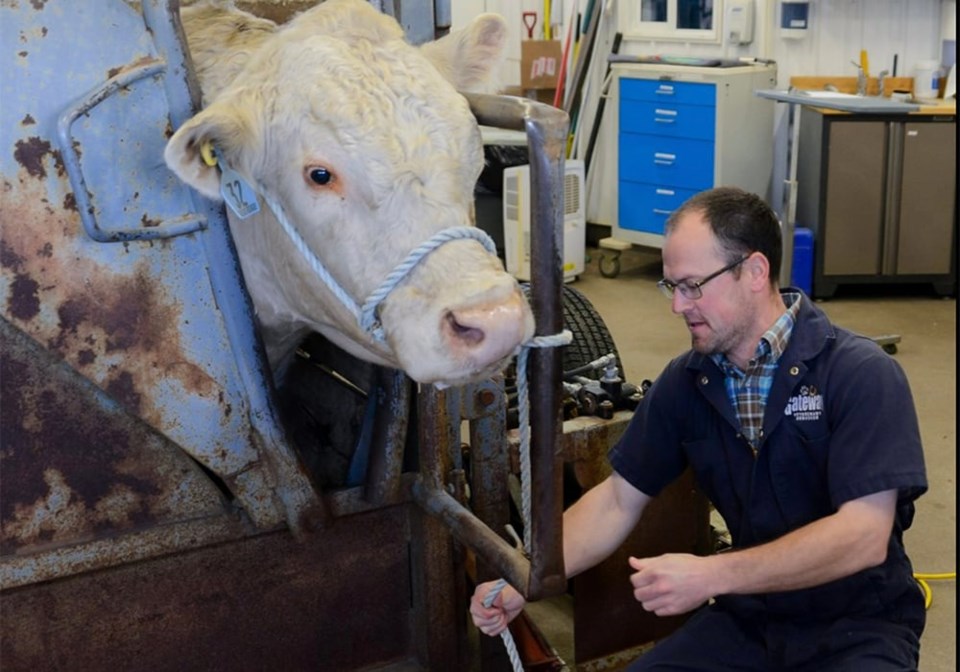WESTERN PRODUCER — For young adult 4-H livestock division participants, strengthening relationships throughout the agricultural field is important to their current and future endeavours.
Dennis Kotowich, assistant 4-H leader of the Elk Point beef club in Elk Point, Alta., believes members must become acquainted with as many aspects of the industry as possible to increase their chances of success should they eventually run their own operations.
“Margins are so slim in our industry and the acceptable loss error is next to nothing,” he says. “If these kids aren’t exposed to everything from cow-calf operations to packing plants and all points in between, they’ll lose out. We need them to gain the experience of multiple viewpoints and options to get as much bang for their buck as possible.”
As a starting point, Kotowich, who runs 730 mostly Simmental-Hereford crossbred females on Evergreen Farms Ranch near St. Paul, Alta., emphasizes health and nutrition to his club participants.
His group recently visited a local veterinarian who spoke about herd health, including vaccination protocols, respiratory diseases, hoof care, pre- and post-breeding inoculations, parasite control and embryo transfers.
“It’s important they hear from veterinarians as they have the knowledge and authority to speak about everything health related, plus, they can weigh in on nutritional aspects, such as minerals and supplements.”
Kotowich also organized a field trip to Highland Feeders in Vegreville, Alta., a 30,000-head feedlot.
“Some of our members had never been to a feedlot. It’s hard to describe to those who’ve never experienced it. So much goes into raising healthy animals. Situations regarding care often come up and stump us so having multiple viewpoints, including those from vets, always helps.”
He explains each sector of the industry counts heavily on their counterparts from the cow-calf owner to the backgrounder, feedlot operator, finishing yard and packer.
“I tell them all these aspects have a hand in animal health,” he says. “We need our calves to be as strong as possible from the day they’re born to the day they move on. It’s not enough to say ‘good riddance’ when they’re sold down the chain. Whether they change hands or not, if they’re not handled properly, big losses will occur and eventually affect all of us who make up the chain.”
Kotowich trusts in the potential of the local club’s young adults and suggests some will eventually become veterinarians, animal science academics or hold influential positions in the agricultural field.
“A half dozen of our 18 kids will likely have their own cow herd in the future, another four or five will end up working in agriculture or on a farm somewhere. That’s significant. When they get there, they’ll have much more knowledge and experience to draw on.”
Victor Kernaleguen, owner of Gateway Veterinary Services in Melfort, Sask., also believes maintaining a solid relationship with 4-H members is key to helping them have more productive and healthier animals.
He credits his aunt, who is also a veterinarian, with boosting his interest in 4-H and the health field. When he opened Gateway Services, he followed her lead and began buying 4-H steers to support the program. From there, his contributions morphed into representing achievement day activities as on-call veterinarian, holding formal presentations and hosting weigh days for the local clubs.
“It’s extremely valuable to have a positive relationship with the kids,” he says. “The biggest thing is showing them their choices influence health and become a large factor in how their animals turn out. There’s much more joy connected with healthy, happy animals than sick ones. Exposure to vets and what we do helps fulfil this realization.
“We try to teach how to manage risk by 小蓝视频 proactive with vaccines and parasite control,” he says. “From an overall basis it’s more than just diseases. There’s prevention, treatment, and nutrition.
“We want them to make strong decisions about feeding properly, minerals, vaccination protocols, implants and using antibiotics judiciously when needed. When their animals move on, we want them to be comfortable in the fact they’ve done all they could to make them the best they could be.”
Kernaleguen sees his role when interacting with 4-H members as planting the seed of animal care and exposing them to the health side of the equation.
He admits challenges arise when wide variations of ages, experience levels and philosophical beliefs come together. However, he stresses information is vital to help 4-H members understand their choices.
“That’s what it’s about for me,” he says. “Helping them learn new ideas and exposing them to all the possibilities so they can make informed decisions for their own futures.”


